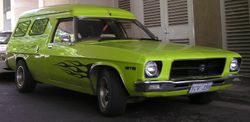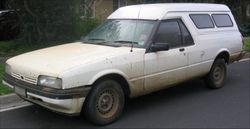Panel van
Car Show
Panel van
 An Australian
Holden panel van, HQ model from 1971-1974
An Australian
Holden panel van, HQ model from 1971-1974
 An Australian Ford panel van, based on a 1990 Ford Falcon
An Australian Ford panel van, based on a 1990 Ford Falcon
A panel van (or panelvan) is a form of
van, usually one
based on a family
car
chassis. They were especially popular with younger car buyers in Australia
during the 1970s.
Australian panel vans
In Australia, panel vans were a development of the Australian
ute (a variety of
pickup also
based on a car chassis). By the late 1980s, they began to slowly disappear from
Australian roads as demand fell and major manufacturers slowly ceased building
them.
Most utes usually had an option of metal, then later rigid plastic, shells
that would fit over the back of the tray of the ute, thereby extending the
vertical space drivers could store in the tray, usually to just above the
existing roofline of the passenger cab. Later shells offered plastic windows for
ventilation along the sides and even pop-out or swing-out windows at the rear to
aid the driver's rear vision. These were eventually integrated into the body of
the ute itself to form a hybrid vehicle that, while based on a ute body, offered
more rear space than a conventional station wagon with its rear seats folded
down. These became known to the Australian public essentially as panel vans.
Initial models were fitted at the rear with swing-down and -up doors (like
utes), but later models came equipped with "barn-door" configurations that
opened out to the sides of the vehicle, rather than down, aiding the loading of
bulky freight into the vehicle without (as badly) damaging the body. Passengers
could climb from the interior passenger cab into the cargo bay behind them
easily. Later the installation of safety cages which segregated passengers from
the cargo area became popular to prevent freight from the back sliding into the
passenger cab (and potentially injuring the driver).
The first panel vans were manufactured by
Holden and Ford in the late 1950s, but didn't become popular until the
mid-1960s. By the early 1970s, usually when based on the Holden Kingswood and
Ford Falcon model of the time, panel vans had become Australian cultural icons.
The Holden Sandman is probably the best-remembered of these: for example, one of
the vehicles driven by Mel Gibson in the 1979 movie Mad Max was a Sandman
(apparently a 1975 "HJ" model in this case)(The panelvan in Mad Max was not a
Sandman, But a customised HJ Kingswood panel van). Ford panel vans (known
briefly as Sundowners) were also popular, to a lesser degree. Chrysler also came
to the party in 1976, offering a CL-model Valiant panel van dubbed the Chrysler Drifter, but these could not compete
with the popularity of Ford and particularly Holden, and were axed in 1978.
Younger drivers were especially attracted to panel vans, for reasons such as
the ease with which a mattress could be installed within the cargo bay.
Consequently, panel vans also attracted nicknames such as "sin bins", "shaggin'
wagons", and "fuck-trucks". During the 1970s it also became fashionable to
decorate the exterior sides with murals painted with intricate detail.
Australian police forces also purchased fleets of panel vans to use in a
black maria, or paddy wagon, role. In Melbourne, panel vans were known in police
terminology as divisional vans, giving rise to the localised slang term divvy van (and the drinking chant, "we're going
home in the back of a divvy van!").
Painters, electricians, and general labourers also found panel vans ideal for
their trades, as the cargo bay offering extended capacity otherwise wasted in
passenger space, and a highly customisable interior, without the bulk or
extended dimensions of other longer-base vans.
The popularity of panel vans has waned however the last 20 years: Holden's
last release was their "WB" model, in
1983. Subsequently, Ford became the sole manufacturer of them until 1997, when
the "XH" model was released; this was to prove the last entry in the history of
the Australian panelvan. In 2003, Holden released a new Sandman, based on their
"VU" model Holden Commodore of the time. These Sandmans were a limited edition release,
and while they were identified (and marketed) as panel vans, they still retained
the rear window and firewall of the ute they were ultimately based on,
preventing movement between the cargo bay and the passenger cab, as offered by
traditional panel vans.
See also
External link
Home | Up | A-pillar | Bangle-butt | Brougham | Cab forward | Cabrio coach | Coupe | Crew cab | Dune buggy | Fastback | Hackney carriage | Hardtop | Hatchback | Hearse | High Wheeler | Kammback | Landau | Notchback | Panel van | Phaeton body | Retractable hardtop | Roadster | Runabout | Sedan | Shooting-brake | Softtop | Sportwagon | Spyder | Stanhope body | Station wagon | Cabriolet | Convertible | Leisure activity vehicle | Minivan | Pickup truck | T-bucket | T-top | Targa top | Three window coupe | Tonneau | Touring car | Van | Woodie
Car Show, made by MultiMedia | Free content and software
This guide is licensed under the GNU
Free Documentation License. It uses material from the Wikipedia.
|







